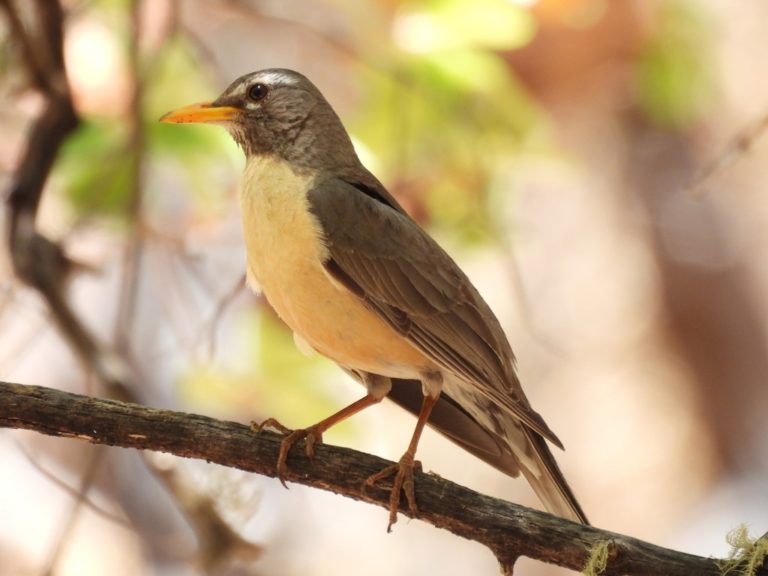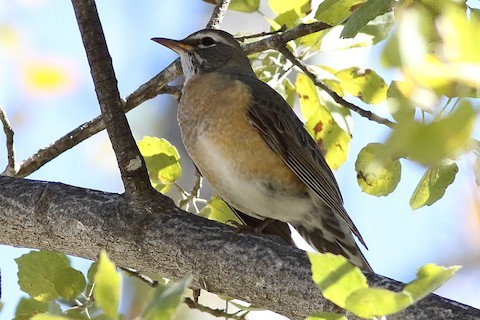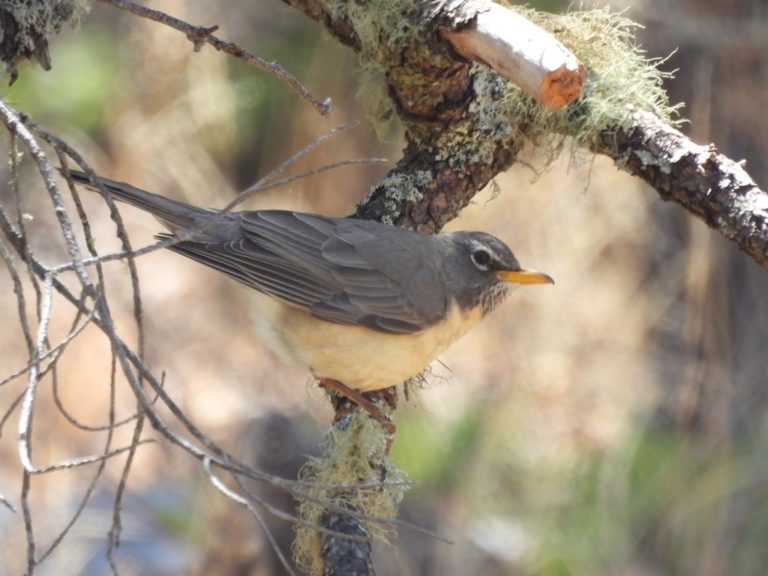Birdfinding.info ⇒ The Baja California endemic form of the American Robin is common but extremely localized in pine-oak forests at upper elevations of the Sierra de la Laguna. The most readily accessible site is the trail from La Venta (along Route 1) south to San Antonio de la Sierra. It can sometimes be found along the lower part of the trail near the highway, and becomes more numerous several kilometers up the trail.
“San Lucas Robin”
Turdus migratorius confinis
Endemic to the Sierra de la Laguna in the Cabo San Lucas region of Baja California Sur, where it is mostly confined to montane pine-oak forests around the elevations 1,000-2,000 m. Sometimes wanders lower, mainly in winter.
Identification
An isolated, pale, washed-out version of the abundant, widespread American Robin, with which it is generally regarded as conspecific.

“San Lucas Robin”, T. m. confinis. (Sierra de la Laguna, Baja California Sur, Mexico; May 25, 2022.) © Osiel Flores

“San Lucas Robin”, T. m. confinis. (Sierra de la Laguna, Baja California Sur, Mexico; March 6, 2011.) © Steven Mlodinow
The “San Lucas Robin” differs mainly in having buffy underparts, gray or grayish-brown upperparts, a much longer white brow stripe, and no noticeable differentiation between the sexes.
Notes
Monotypic form, one of two potentially distinct forms of the American Robin (migratorius).
Several authors and taxonomic authorities have regarded the “San Lucas Robin” as a separate species, recently including the Handbook of the Birds of the World and BirdLife International, while others regard it as a geographically isolated pale race of migratorius. In 2022, the American Ornithological Society Classification Committee rejected a proposal to reclassify confinis as a separate species.
More Images of the “San Lucas Robin”

“San Lucas Robin”, T. m. confinis. (Sierra Las Pirras, Baja California Sur, Mexico; March 21, 2022.) © Daniel Lopez Velasco

“San Lucas Robin”, T. m. confinis. (Sierra Las Pirras, Baja California Sur, Mexico; March 21, 2022.) © Daniel Lopez Velasco

“San Lucas Robin”, T. m. confinis. (San Antonio de la Sierra, Baja California Sur, Mexico; January 30, 2020.) © Steven Mlodinow

“San Lucas Robin”, T. m. confinis. (San Antonio de la Sierra, Baja California Sur, Mexico; December 12, 2020.) © Mark L. Hoffmann

“San Lucas Robin”, T. m. confinis, immature. (Sierra de la Laguna, Baja California Sur, Mexico; March 6, 2011.) © Steven Mlodinow

“San Lucas Robin”, T. m. confinis, immature. (Sierra de la Laguna, Baja California Sur, Mexico; January 19, 2009.) © Steven Mlodinow

“San Lucas Robin”, T. m. confinis, juvenile. (Sierra de la Laguna, Baja California Sur, Mexico; August 8, 2009.) © Steven Mlodinow
References
American Ornithological Society. 2021. AOS Classification Committee – North and Middle America, Proposal Set 2022-A (October 13, 2021; revised December 1, 2021). https://americanornithology.org/wp-content/uploads/2022/04/2022-A-final.pdf.
BirdLife International. 2021. Turdus confinis. The IUCN Red List of Threatened Species 2021: e.T103889802A139411747. https://dx.doi.org/10.2305/IUCN.UK.2021-3.RLTS.T103889802A139411747.en. (Accessed August 20, 2022.)
eBird. 2022. eBird: An online database of bird distribution and abundance. Cornell Lab of Ornithology, Ithaca, N.Y. http://www.ebird.org. (Accessed August 20, 2022.)
Howell, S.N.G., and S. Webb. 1995. A Guide to the Birds of Mexico and Northern Central America. Oxford University Press, Oxford.
Xeno-Canto. 2022. American Robin – Turdus migratorius. https://xeno-canto.org/species/Turdus-migratorius. (Accessed August 20, 2022.)
